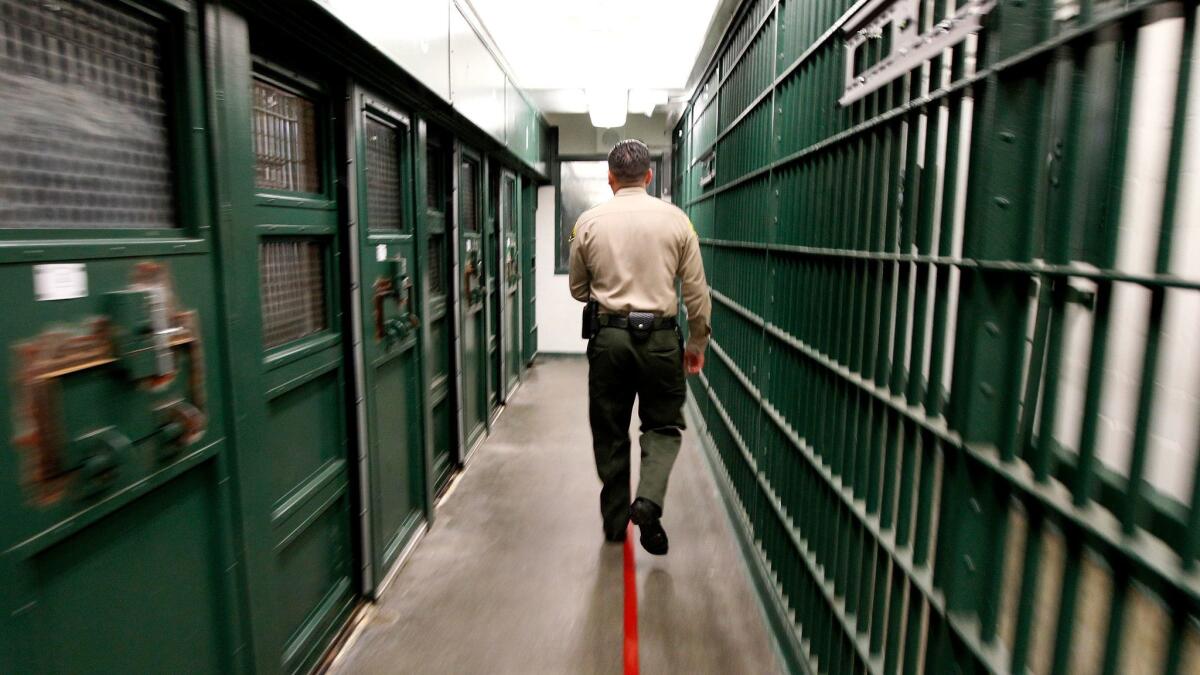California releases more jail inmates amid coronavirus crisis

- Share via
More California counties are releasing inmates to protect their jails against possible coronavirus outbreaks.
In Alameda County, officials announced 247 people were being released from the Santa Rita Jail in Dublin. San Diego County officials have announced similar moves, as have San Francisco, San Mateo and other counties.
The Los Angeles County Sheriff’s Department has reduced its inmate population by 6% in the last three weeks and Dist. Atty. Jackie Lacey said her office would consider reducing bail for thousands of nonviolent offenders.
As of Thursday morning, there were no confirmed cases of the virus inside L.A. County jails, where the number of inmates was down to 16,017 inmates from 17,076 on Feb. 28.
“We anticipate the count is going to go further down,” said Cmdr. Jason Wolak of the Sheriff’s Department’s Custody Division. “The reason why we’re doing it is so we can have flexibility in the jail in case we’re going to lose a part of it [to quarantine].”
The county’s sprawling jail system is the largest in the nation, and many civil rights groups and others have pushed to reduce incarceration levels to prevent lockups from becoming breeding grounds for spread of the virus.
Nine inmates were in isolation and getting tested for the virus at the Correctional Treatment Center, where everyone must get their temperature scanned before entering, Wolak said. Elsewhere, 109 more inmates were being quarantined.
Since public visitation has been suspended, inmates are being offered two five-minute phone calls per week for free, Wolak said. Wolak said the Sheriff’s Department is regularly hosting town halls for inmates, advising them about social distancing and to wash their hands, while also distributing more cleaning supplies.
Sheriff Alex Villanueva said earlier this week that he was speeding up the release of inmates with less than 30 days of jail time left to serve, and citing, instead of arresting, people whose alleged offenses carry a bail of less than $50,000. That doesn’t include people suspected of domestic violence.
The Sheriff’s Department is now also looking at potentially releasing pregnant women and older adults at a higher risk for contracting the virus, Wolak said.
Lacey said Thursday that her office would consider, case by case, reducing the bail of 2,000 pretrial inmates the Sheriff’s Department has identified as nonviolent offenders. She expected to receive a list on Friday, she said.
Lacey said her office would also review cases coming up for trial in the next 30 days to identify defendants who could be released on their own recognizance. A judge would have to approve any bail modifications.
“We’re looking for cases where no one was hurt, there was nobody threatened to be hurt, they don’t have anything in their prior record that indicates they’re capable of violence,” she said.
Starting next week, Lacey said, she hopes the courts will be able to get through 300 bail hearings a day, some of which will be conducted by phone.
Robin Steinberg, chief executive of the Bail Project, called on Villanueva and Lacey to work to immediately release any defendants who are being held solely because they cannot pay their bail, unless that person has been deemed a danger to the public.
Meanwhile, California has shut down the movement of inmates between state prisons, and state psychiatric hospitals have closed their doors to inmate admissions or discharges — actions intended to mitigate spread of the virus. A new internal memo, provided to lawyers in a federal prison overcrowding case, shows the Corrections Department plans to screen all incoming inmates, putting any who have a temperature or other signs of illness in isolation and the rest into quarantine for 14 days.
The memo instructs prison medical teams to triage inmates with flu-like symptoms at their cell door, while wearing protective garb, and move them only for “urgent or emergent care.”
Prison administrators were told to try to implement social distancing, such as keeping six feet between inmates, avoiding groups of 10 or more and reassigning bunk bed assignments to keep prisoners apart as much as possible, even as the same policy notes “not all strategies will be feasible.”
Prison visitation and volunteer and education programs have already been shut down, and some 1,800 inmates were placed in quarantine at San Quentin State Prison after several developed flu-like symptoms. However, state corrections officials say there are no confirmed cases of COVID-19 among prisoners, though they have not revealed how many have been tested.
Lawyers for inmates have told a federal judge they are concerned that there are not adequate provisions for inmates with mental illness.
“The shortages of clinical and custody staff, as well as of treatment space and specialized beds, leave little or no margin to address this crisis,” they wrote in a motion filed Thursday night, on the eve of a planned telephone conference Friday with the federal court. “Whatever plan Defendants do develop ... must include a rapid and major reduction in the number of prisoners requiring mental health services through various methods available to Defendants in this emergency.”
“Overcrowding makes something like this impossible,” said inmate attorney Michael Bien. “I’m very worried about it.”
More to Read
Sign up for Essential California
The most important California stories and recommendations in your inbox every morning.
You may occasionally receive promotional content from the Los Angeles Times.













